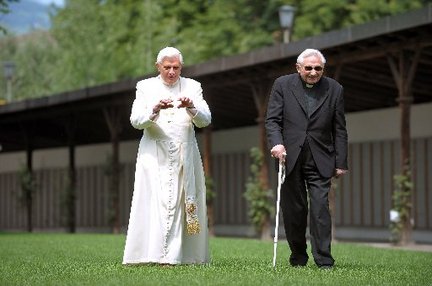The Star-Ledger
April 13, 2010
http://blog.nj.com/njv_guest_blog/2010/04/pope_benedict_xvi_and_the_chur.html
 |
| Pope Benedict XVI (left) as he walks with his brother Bishop Georg Ratzinger in the garden of his holiday residence in Bressanone. Photo by OSSERVATORE ROMANO/AFP/Getty Images |
Pope Benedict is at the center of the storm in the latest pedophile scandal to wrack the Roman Catholic Church.
In 1980, as Cardinal Joseph Ratzinger, archbishop of Munich, he allegedly allowed a priest accused of abuse to return to pastoral work after receiving psychiatric care. The priest was later convicted of abusing boys at another parish. For nearly 24 years, Ratzinger led the Vatican office known as Congregation for the Doctrine of the Faith, and he has been criticized for moving slowly to defrock abusers whose cases came before his office.
Linda Ocasio of The Star-Ledger Editorial board spoke with David Gibson, author of a biography of Benedict XVI, "The Rule of Benedict," and religion reporter for www.PoliticsDaily.com. This is an edited transcript of that interview.
Q: What distinguishes this crisis from past controversies involving the Roman Catholic Church?
A: It touches on the credibility of the pope. We havenít had that in a long time. The last time was with Pius XII and the allegations that he did not take sufficient action to protect Jews during the Holocaust, and that was 60 years ago. Thereís nothing new about disagreements with the pope. But theyíve been on doctrine or politics. Not on the popeís reputation.
Q: How is Pope Benedict handling the crisis?
A: Benedict is not big on apologizing and this would require him to speak in the first person about himself, what he knew and when he knew it. Thereís a deafening silence at the center of this crisis, and itís the silence of Benedict. Yet other popes have been forthright, in particular John Paul II. He was a public figure, comfortable in the spotlight. He was famous for apologizing for past sins, anti-Semitism, discrimination against women, the sins of the Reformation. He made very public and sincere apologies, albeit for things that happened far in the past and that he wasnít personally responsible for.
Q: The repeated sex-abuse scandals, many involving children, have people asking, why are there so many pedophiles in the priesthood?
A: There is no evidence that there are more pedophiles in the Catholic Church than in other institutions, such as teaching or the Boy Scouts. There is a problem of accountability at the top, and how bishops dealt with abusers or did not. They shuffled them around to parishes for years or decades, and that enabled a single abuser to have hundreds of victims. So some bishops turned criminals into monsters.
Q: What can be done to prevent pedophiles from entering the priesthood?
A: Since bishops revamped the seminaries in the early 1980s and introduced better psychological screening, abuse in the Catholic Church has dropped sharply. Itís not enough ó you always have to be vigilant. There are safe-environment policies in churches, parishes and schools guiding interactions between adults and children, such as having an open door when meeting with a child, or having two adults in sight for confession. What the church also needs is accountability among the bishops, and that has proved more difficult. There have been occasions when bishops have not followed their own policies on reporting charges of abuse and following up with investigations. The lack of a disciplinary policy for bishops is also a problem.
Q: Will the pope resign?
A: No, the pope wonít resign unless something cataclysmic happens. But will he be permanently wounded in terms of credibility, thatís the big question. This has been a very tough stretch for the pope, and how much he recovers from it, I donít know. He remains the pope and over time he may recover, but this has done his reputation grievous harm.
Any original material on these pages is copyright © BishopAccountability.org 2004. Reproduce freely with attribution.